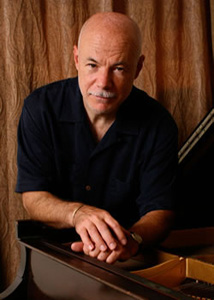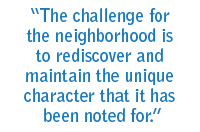 Pianist, composer, and arranger Larry Ham has been long noted as a New York sideman performing, touring, and recording with many great jazz artists. He’s now gaining new recognition as a solo artist with his latest CD release “Just Me, Just You” on Arbors Records. He lives with his wife, the artist Sally Halverstadt, and their son, Nick, on Bleecker Street between Charles and Perry.
Pianist, composer, and arranger Larry Ham has been long noted as a New York sideman performing, touring, and recording with many great jazz artists. He’s now gaining new recognition as a solo artist with his latest CD release “Just Me, Just You” on Arbors Records. He lives with his wife, the artist Sally Halverstadt, and their son, Nick, on Bleecker Street between Charles and Perry.
Musician Larry Ham grew up on a dairy farm in upstate Millbrook, a place where his family had roots stretching back three centuries. “My family is an old Dutch one who settled a farm there in the early 1700s,” he says. “The schoolhouse that my wife and I bought and converted to our weekend getaway is where my dad, grandfather, and great-grandfather attended school.”
Included in the farmhouse where Ham grew up was a Steinway piano that a great-great-great-aunt had bought in 1888. “Nobody ever played it much,” he recalls. “But my mother decided that all of her children should have piano lessons. She’s the musical side of our family, although she never had any training. As for Dad, he was a farmer. He didn’t play an instrument and doesn’t appear to be musical, but he certainly has an aesthetic nature. He loves the beauty of the natural world. And when he drove around the farm in the pickup truck he was always tuned into the classical station!”
So how did a farm boy with classical training wind up playing jazz piano? Particularly, as Ham says, “You didn’t hear much jazz on a farm back in the 60s or early 70s!” It happened when he was finally living on his own. “One day someone gave me a John Coltrane recording and I just about fell over,” he recalls. “Just trying to imagine the kind of human story that was being told through that music made me want to get closer to it. It was pretty much like the ‘Saul on the Road to Damascus’ story: an instant conversion. So I bought a used piano and just started practicing. I found a teacher who told me to listen to this particular record, practice these chords, and I pretty much followed my sense that this was going to be my path in life.”
After graduating college, Ham played around for a couple of years in the Catskills and on cruise ships, eventually moving to New York where he settled in Inwood. “That neighborhood was a little rough in the mid-eighties,” he recalls. He met his wife at a party and after a while moved into her apartment on Bleecker Street and has lived there since 1990. For them, the Village was a great neighborhood to raise their son. “It’s comfortable and quiet enough for that,” Ham admits.
 Addressing the kinds of changes he’s seen in the West Village since moving here, Ham singles out the stores that now line his block. “We’re right in the middle of a high-end clothing retail evolution here,” he observes. “It used to be much more “Mom and Pop”, with a Laundromat on the corner and little stores that had been here for a long time. Now it’s become very expensive commercial property. I think that makes it a little less unique. Of course, we’re all unique. But there’s something a little less singular about the character of the neighborhood. I sometimes walk down my street and wonder why they don’t put a roof over it and call it a mall,” he notes, laughing. “Then it would be all-weather!”
Addressing the kinds of changes he’s seen in the West Village since moving here, Ham singles out the stores that now line his block. “We’re right in the middle of a high-end clothing retail evolution here,” he observes. “It used to be much more “Mom and Pop”, with a Laundromat on the corner and little stores that had been here for a long time. Now it’s become very expensive commercial property. I think that makes it a little less unique. Of course, we’re all unique. But there’s something a little less singular about the character of the neighborhood. I sometimes walk down my street and wonder why they don’t put a roof over it and call it a mall,” he notes, laughing. “Then it would be all-weather!”
When asked what he thinks some of the biggest challenges are facing the West Village these days, Ham responds, “For me, the biggest issue is that there aren’t many artists in the neighborhood anymore. It’s just impossible for them to afford the properties and that’s changed the character of things. So the challenge for the neighborhood is to rediscover and maintain that unique character that it has been noted for and to find ways to keep its identity.”
He continues. “I’ve been on the board of my coop almost since I moved here and it’s really interesting the kinds of money now that come to buy apartments. People have piles of money now. That’s something that my wife and I are grateful for in the sense that we’ve realized such an appreciation on our own investment. It’s actually allowed us to borrow some money to fix up our place upstate. So you can’t really complain. But there still is a certain nostalgia for when things were a little simpler and a little more neighborhood.”
Photo: Ira Fox
